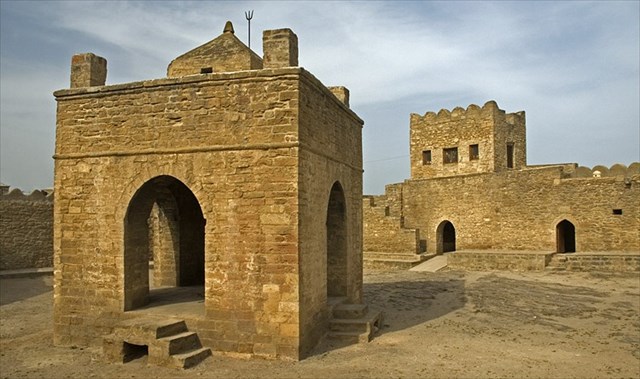Iran has many archaeological wonders to admire from ancient time. One of them is the Zoroastrian fire temple Atashgah in the big city Esfahan – Isfahan. It is well constructed and has its own charm, but cannot compete with other Iranian wonders which are notified on UNESCO’s World Heritage list as Bam and its Cultural Landscape (2004), Pasargadae (2004), Persepolis (1979), Soltaniyeh (2005), Takht-e Soleyman (2003), Tchogha Zanbil (1979) and the amazing building the Meidan Emam Mosque in Esfahan (1979). Anyway Atashgah is a great wonder. Other great wonders in Esfahan are the Friday Mosque, the Shaky Minarets, Christian churches in the Jolfa district and the bridges across the Zayandeh river. The mentioned Zoroastrian fire temple is rising up from the top of a hill. It`s the only one in Esfahan and there is special story behind it.
Atashgah – a Zoroastrian fire temple on the top of a hill outside the center of Esfahan. It was inspired by the Zoroastrianism, which was the main religion of the two great dynasties of ancient Persia, the Achaemenids and Sassanids.
Esfahan or Isfahan is considered as one of the most beautiful cities in the world. Its located about 340 kilometres south of Tehran, and is the capital of Isfahan Province and Iran’s third largest city after Tehran and Mashhad. Its population is over 2 million.
Esfahan has been designated by UNESCO as a world heritage city. It contains a wide variety of Islamic Architectural sites ranging from the 11th century to the 19th. One of ancient wonders in Esfahan, as mentioned, who is not noticed by UNESCO, is the Atashgah – the Zoroastrian fire temple.
Esfahan has a violent history, and has lost many great wonders due several wars. Before the Arabs invaded Iran, there were many fire temples in Esfahan. The Arabs destroyed them all, except this one on top of a hill. So why did this temple survive? It`s steep and very hard to climb up the hill where the temple stands, especially in the summer. Perhaps the Arabs were so exhausted after the climbing to the top of this hill that they had no energy left to destroy it.
The Arabs ruled in Esfahan until 1050. They converted most of the population to Islam. They were fought back by a Turkish dynasty, which conquered Esfahan in 1051.
The Turks were thrown out by Genghis Khan’s Mongol warriors in the early 13th century, but become later squeezed out again by Turkmen tribes, Ottoman Turks and European colonialists such as Portugal. The city been has benn invaded several times since then and the situation has through centuries been very unstable until late in the 20th century.
Zoroastrianism was once the state religion of Sassanid – Sassanian – in Iran, and was central in the Achaemenid and Parthian empires in Persia – now officially called Iran. The religion is also known as Mazdaism by some followers and Zarathustrianism by others.
Many traits of the Zoroastrian faith are still present in all Iranian peoples’ cultures and traditions from Kurdistan and the Caucausus to Iran and Central Asia. As Lonely Planet (www.LonelyPlanet.com) writes on its website: “Iran’s religiousness is its most striking cultural feature – it pervades all aspects of life.”
The beauty of the city, the amazing wonders and the fascinating history, is well worth a visit to Esfahan.

Comment (0)